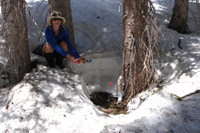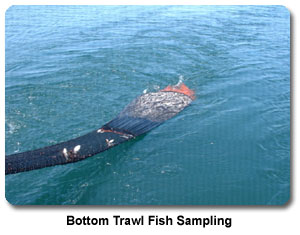- Home
- About S&T
- Taxa/Organisms
- Ecosystems
- Issues
- Methods & Tools
- Reports & Publications
- Location
- Search
Publisher: NBII | Format: URL
pollinators.nbii.gov — The global declines in many kinds of pollinator species could potentially impact the global food supply, as many plants depend upon specific pollinators to reproduce. The Web site of the NBII Pollinators Project provides access to information about the biology, ecology, conservation status, and threats to native pollinators, pollinator-dependent More...

Publisher: USGS | Science Center: Patuxent Wildlife Research Center (PWRC, Laurel) | Format: URL
www.pwrc.usgs.gov — Dr. Howard Ginsberg is studying the transmission of Lyme disease spirochetes in nature using ecological studies of ticks and their vertebrate hosts, and models of spirochete transmission dynamics. Environmental factors that influence tick populations apparently operate on a regional scale. Distribution of vertebrate hosts plays a role in tick More...

Publisher: USGS | Science Center: Fort Collins Science Center (FORT, Ft. Collins) | Format: URL
www.fort.usgs.gov — Encroaching development, overuse, and air- and waterborne contaminants from outside park boundaries are causing noticeable changes to water quality and ecosystem health and functioning. The Front Range metropolitan area from Fort Collins south to Colorado Springs includes 75 percent of Colorado's population and its most productive agricultural More...

Publisher: Other Federal Agency (National Park Service (NPS)) | Format: URL
science.nature.nps.gov — This website represents National Park Service Inventory and Monitoring Program's goal to collect, organize, and make available natural resource data and to contribute to the Service's institutional knowledge. Its goals are to inventory the natural resources under National Park Service stewardship to determine their nature and status; monitor park More...

Publisher: USGS | Science Center: Pacific Island Ecosystems Research Center (PIERC, Honolulu) | Format: URL
biology.usgs.gov — Ants are not native to Hawaii and are a significant threat to endemic insects which have not evolved in their presence. This resource is a study of the palila, an endangered honeycreeper that inhabits the dry subalpine slopes of Mauna Kea. The ants are a threat because they are potential predators of insects upon which the Palila feed.

Publisher: USGS | Science Center: Northern Prairie Wildlife Research Center (NPWRC, Jamestown) | Format: URL
www.npwrc.usgs.gov — Caterpillars of Pacific Northwest Forests and Woods are well represented among the total number of insects. The caterpillar is the immature stage of moths and butterflies that are abundant on certain plants at various times of the year. This booklet is a field guide with keys to the identification of caterpillars commonly found in forests and More...

Publisher: USGS | Science Center: Great Lakes Science Center (GLSC, Ann Arbor) | Format: URL
www.glsc.usgs.gov — The USGS Great Lakes Science Center (GLSC) has a long history of significant contributions to the understanding of aquatic resources in the Great The main focus of the Center's research is on the long-term dynamics of native and non-native aquatic species and the sustainability of Great Lakes fisheries. Since the Center was established, the fish More...

Publisher: USGS | Science Center: Western Fisheries Research Center (WFRC, Seattle) | Format: URL
wfrc.usgs.gov — The Popo Agie Conservation District (PACD), headquartered in Lander, Wyoming, is developing a management plan for the Popo Agie Watershed. A key component in developing an effective management plan is the need for a scientifically valid and rigorous monitoring program. Paramount in this monitoring is the need to identify leading indicators of More...

Publisher: USGS | Science Center: Pacific Island Ecosystems Research Center (PIERC, Honolulu) | Format: URL
biology.usgs.gov — The geographical isolation of the Hawaiian Islands has resulted in the evolution of a highly endemic biota: approximately 80 percent of Hawaii's plants, 100 percent of its forest birds, and 67 percent of its arthropods are found nowhere else in the world. But human colonization of the Islands has severely impacted native plant and animal More...

Publisher: NBII | Format: URL
www.nbii.gov — Natural resource managers face complex decisions that require a clear understanding of the status of wildlife populations and their habitats. Monitoring is key to making effective management decisions and evaluating the outcomes of those decisions. The goal of NRMP is to improve the accessibility of monitoring efforts to resource managers to aid More...

Publisher: USGS | Science Center: Fort Collins Science Center (FORT, Ft. Collins) | Format: URL
www.fort.usgs.gov — Natural Resource Monitoring Partnership (NRMP) is a collaborative effort by the natural resource management community to improve monitoring efforts in order to support effective evaluation and decision-making by sharing information on monitoring projects and protocols. The Natural Resource Monitoring Partnership was built for easy access to More...

Publisher: NBII | Format: URL
frames.nbii.gov — The Fire Research And Management Exchange System or FRAMES is a systematic method of exchanging information and transferring technology between wildland fire researchers, managers, and other stakeholders. In partnership with the US Geological Survey's National Biological Information Infrastructure (NBII) Program, FRAMES is implementing web-based More...
